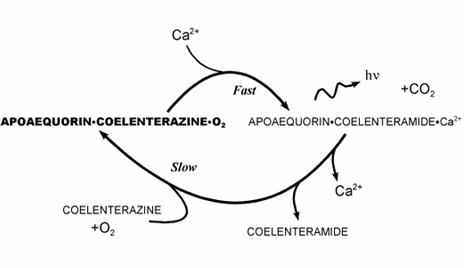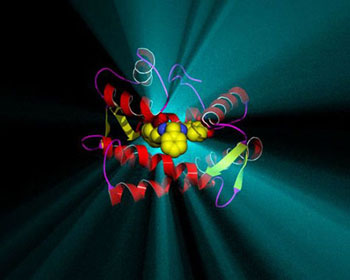Team:Valencia/WetLab/YeastTeam
From 2009.igem.org
Cristina VS (Talk | contribs) (→WetLab Overview) |
Cristina VS (Talk | contribs) (→WetLab Overview) |
||
| Line 22: | Line 22: | ||
The project our team imagined is about controlling electrically genetically engineered cells to induce a desired behavior. In particular, our Project had the ambitious goal of making LECs (Light Emitting Cells). | The project our team imagined is about controlling electrically genetically engineered cells to induce a desired behavior. In particular, our Project had the ambitious goal of making LECs (Light Emitting Cells). | ||
| + | |||
In order to do so, we have worked with a bioluminiscent protein named aequorin. Aequorin is present in jellyfish and it is responsible of the emission of Light by these marine invertebrates. In order for aequorin to produce Light, this protein has to be coupled to a prostetic group: coelenterazine. Coelenterazine is oxidized when calcium ions bind to the aequorin-coelenterazine complex and, as a result, light is emitted. This is not a fluorescent reaction, as aequorin do not need to be excited with UV light. | In order to do so, we have worked with a bioluminiscent protein named aequorin. Aequorin is present in jellyfish and it is responsible of the emission of Light by these marine invertebrates. In order for aequorin to produce Light, this protein has to be coupled to a prostetic group: coelenterazine. Coelenterazine is oxidized when calcium ions bind to the aequorin-coelenterazine complex and, as a result, light is emitted. This is not a fluorescent reaction, as aequorin do not need to be excited with UV light. | ||
| Line 32: | Line 33: | ||
But our aim was to control electrically our LECs, so we tried to induce a membrane depolarization by supplying electricity to our yeasts and open voltage-dependent calcium channels to produce a calcium entry to cytosol and, as a result, get light emission. | But our aim was to control electrically our LECs, so we tried to induce a membrane depolarization by supplying electricity to our yeasts and open voltage-dependent calcium channels to produce a calcium entry to cytosol and, as a result, get light emission. | ||
| - | |||
| - | |||
| - | |||
| - | |||
| - | |||
| Line 43: | Line 39: | ||
If we succed in this, we will try to reproduce the same response with an '''electrical stimulus''', using some hardware built by ourselves. We will use an electrical input to open the Ca<SUP>2+</SUP> channels. We hope that we see light by this metod.--> | If we succed in this, we will try to reproduce the same response with an '''electrical stimulus''', using some hardware built by ourselves. We will use an electrical input to open the Ca<SUP>2+</SUP> channels. We hope that we see light by this metod.--> | ||
| - | [[Image: | + | [[Image:Aquorin in action.jpg|350px]] |
In summary, we designed a yeast-based system for the production of light through a jellyfish protein sensitive to calcium. Since calcium enters the cytoplasm through voltage channels, it is theoretically possible to have light emission under electrical control. If this was possible, a biological display made of aequorin-expressing yeasts as living pixels could be constructed. | In summary, we designed a yeast-based system for the production of light through a jellyfish protein sensitive to calcium. Since calcium enters the cytoplasm through voltage channels, it is theoretically possible to have light emission under electrical control. If this was possible, a biological display made of aequorin-expressing yeasts as living pixels could be constructed. | ||
Revision as of 17:55, 21 October 2009
WetLab Overview
The project our team imagined is about controlling electrically genetically engineered cells to induce a desired behavior. In particular, our Project had the ambitious goal of making LECs (Light Emitting Cells).
In order to do so, we have worked with a bioluminiscent protein named aequorin. Aequorin is present in jellyfish and it is responsible of the emission of Light by these marine invertebrates. In order for aequorin to produce Light, this protein has to be coupled to a prostetic group: coelenterazine. Coelenterazine is oxidized when calcium ions bind to the aequorin-coelenterazine complex and, as a result, light is emitted. This is not a fluorescent reaction, as aequorin do not need to be excited with UV light.
But since we did not want to work with jellyfishes in the lab, we used budding yeast, Saccharomyces cerevisiae, as a simple host for our experiments. We used a genetically modified yeast strain expressing aequorin. This strain has been reported to produce light through a calcium channel-based system in response to a chemical stimulation.
But our aim was to control electrically our LECs, so we tried to induce a membrane depolarization by supplying electricity to our yeasts and open voltage-dependent calcium channels to produce a calcium entry to cytosol and, as a result, get light emission.
In summary, we designed a yeast-based system for the production of light through a jellyfish protein sensitive to calcium. Since calcium enters the cytoplasm through voltage channels, it is theoretically possible to have light emission under electrical control. If this was possible, a biological display made of aequorin-expressing yeasts as living pixels could be constructed.
 "
"

